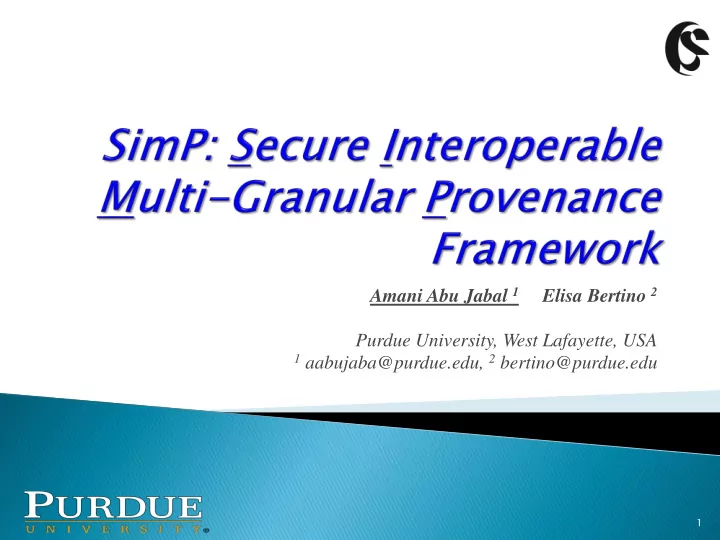

Amani Abu Jabal 1 Elisa Bertino 2 Purdue University, West Lafayette, USA 1 aabujaba@purdue.edu, 2 bertino@purdue.edu 1
Data provenance, one kind of metadata, which refers to the derivation history of a data object starting from its original sources. ◦ Data object refers to data in any format (e.g., files, database records, or workflow templates). Comprehensive provenance infrastructure: ◦ Multi-granular provenance model ◦ Provenance queries ◦ Security ◦ Interoperability services 2
Provenance models tailored to specific applications: ◦ Workflow-based provenance systems: Chimera [ SSDBM’02], myGrid [ ICSNW’04], and Karma [CCPE’08]. ◦ Process-based provenance systems: PreServ [AAAI'13] ◦ OS-based provenance system: PASS [USENIX'06], and ES3 [ IPAW’08]. Standard Provenance Models (OPM and PROV). + Interoperable and Generic. - Not able to represent metadata about access control policies Ni’s model [ SDM’09] focuses on access control policies. - It is not able to support different granularity levels The framework by Sultana and Bertino [JDM’15] is an initial comprehensive provenance infrastructure ◦ Lacks interoperability services. ◦ Not implemented nor integrated with an actual system. 3
Our provenance framework is composed of several components: 4
Main Entities in our model: ◦ Data: a: data object (e.g. files) ◦ Processes: ocesses: activities which manipulate data ◦ Operat eration ions: s: finer level of processes ◦ Ac Actor ors: s: actuator of data/processes (e.g. human) ◦ Environ vironments: ments: system context parameters ◦ Ac Access ess Control ontrols: s: policies placed at the time of data manipulation Our framework supports the specification of the provenance model in two representations: relational and graph . 5
Beside the fundamental tables, there are: ◦ Lineage neages ◦ Comm mmuni unicati cations ons ◦ Process ocess Input/Outp put/Output ut Data ◦ Operat eration ion Input/Out ut/Output put Data ◦ Deleg legati ations ns 6
Our graph model consists of 6 nodes and 12 types of edges. 7
Our framework supports interoperability with two standard provenance models: OPM and PROV. The mapping ontology from PROV to SimP PROV SimP Nodes Agent Actor Entity Data Activity Process, Operation, WasPartOf Edges Used Used WasGeneratedBy WasGeneratedBy WasDerivedFrom WasDerivedFrom WasAssociatedWith WasExecutedBy WasInformedBy WasInformedBy WasAttributedTo WasAttributedTo ActedOnBehalfOf ActedOnBehalfOf 8
Security: ◦ Access control policies ◦ Restrict access to provenance storage Granularity: ◦ Multi-granular Model ◦ Granularity policies 9
Provenance Storage: ◦ Two types of storage: relational database (MySQL) and graph database (Neo4J). ◦ Abstract storage interface: communicates with either MySQL adapter or Neo4J adaptor. Interoperability: ◦ A service for converting from OPM or PROV (XML format) to SimP model. 10
Integrated with Computational Research Infrastructure for Science ( CRIS ). ◦ Used by a community of researchers at Purdue University For integration with CRIS: ◦ Instrumenting component: Use AOP to generate provenance logs (xml format) ◦ Provenance Supplier: Read provenance logs periodically Convert into SimP XML 11
SimP - a comprehensive provenance framework ◦ Includes a provenance model provided with relational and graph specifications ◦ Interoperable with OPM and PROV ◦ Supports multi-granular provenance ◦ Supports security SimP is integrated with the scientific data management system “CRIS”. Future work: ◦ Design and implement specialized query language for our framework ◦ Investigate efficient compression techniques for our provenance model. 12
Th Thank nk you ou 13
Recommend
More recommend